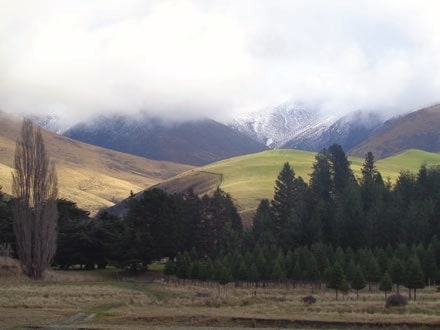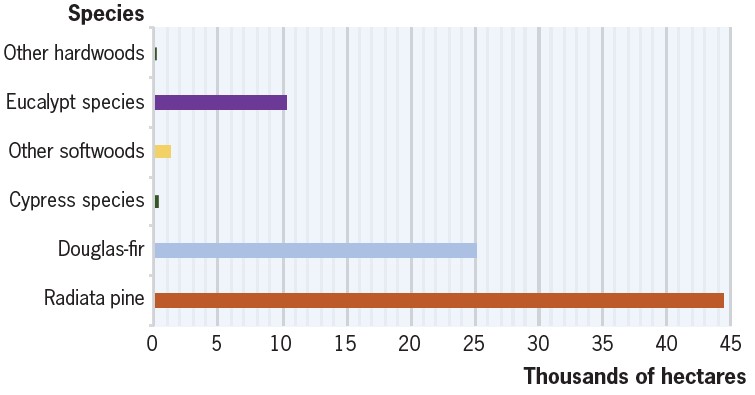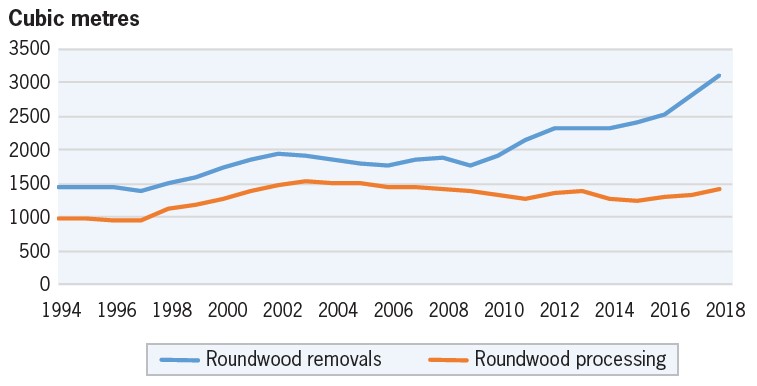Forestry and timber processing in the south: A quiet achiever
New Zealand Tree Grower February 2020.
With the 2020 Conference just around the corner it is an appropriate time to introduce you to the forestry scene in Southland and the rest of southern New Zealand. Forestry has played a major role in the life of Southland for over 150 years, and this will continue in coming decades, with the maturing of small forests and Douglas-fir estates. At a farm and catchment level, forestry is playing an increasingly important environmental role, while the region’s indigenous and exotic forests are the backdrop to a growing tourism industry.
The region you will be visiting during the NZFFA 2020 conference has some impressive statistics. The region is home to 45 per cent of the eucalypt forests in New Zealand, approximately 25 per cent of Douglas-fir plantings and a significant proportion of New Zealand’s indigenous timber production. Of the region’s 3.2 million hectares, 53 per cent is managed for conservation purposes, including the Fiordland World Heritage Area. Plantation forests cover 82,000 hectares, with the bulk of this in the Southland district.
Southland has regularly been at the forefront of innovation in forestry, and recognising emerging trends. A locally based plantation company was one of the first in Australasia to achieve Forest Stewardship Council certification, and the local industry has worked over the years to develop innovative solutions to skill and training challenges. A recent example of this spirit was the support given by the local industry to a three-year project to promote a change to cleaner, sustainable fuels, drawing on wood chips and residues in boiler systems.
This initiative, known as Wood Energy South, was a partnership between the region’s economic development agency and the Energy Efficiency and Conservation Authority. The project has spurred wood chip usage and a shift in community thinking.
In looking at the region, it is important to recognise that Southland’s plantation and processing industries are closely linked to those in Otago. This gives processors, exporters and the two port operators greater economies of scale.

Plantation development in the south
Plantations in Otago and Southland stand at 209,000 hectares, and represent 12 per cent of the national resource. The forestry has its origins in the late 1890s with the establishment of nurseries at Ranfurly and Tapanui which provided the first seedlings for large-scale planting. In 1933 production thinnings from these plantings started to be processed by mills in Southland, but it was not until the post-war period that processing activity really started to ramp up.
By 1990, the combined plantations in Otago and Southland region were116,200 hectares, with 41,100 hectares in Southland and 75,100 hectares in Otago. Over the following decade, Southland’s plantation area climbed by 33,500 hectares from corporate, syndicate and small-scale grower investment. The diversification we see today is mainly a reflection of the investment in Douglas-fir and exotic hardwoods during this period. Across Otago and Southland as a whole, the forestry plantation increased to 186, 600 hectares in the year 2000. Further expansion occurred in the early 2000s, with the plantation area peaking at 216,000 hectares in 2006.
Southland forestry

The composition of Southland forestry is shown in the graph. Southland, and to a lesser extent Otago, has a more diversified landscape than we see in other regions. While radiata pine is 90 per cent of the forestry in New Zealand, in Southland it makes up just 54 per cent.
Douglas-fir is the second largest contributor in Southland estate at 31 per cent of the resource. While a longer term investment, it has an established international reputation, and provides growers and processors with opportunities to diversify markets and products. On higher altitude exposed sites Douglas-fir can be a source of wilding spread. The management of Douglas-fir, and options for higher altitude planting will be one of the strategic themes covered in the conference.
Eucalypts make up 12.6 per cent of regional forestry and have been developed primarily for hardwood chips for pulp and paper manufacturing in Japan. While not on the same scale, Southland and Otago have a cypress resource which has been developed over recent decades. This resource has potential for furniture manufacturing and other high value end uses.
Within Southland, the plantations are concentrated in the Southland district, occupying 77,000 hectares. The Gore district has approximately 4,000 hectares, and Invercargill city, less than 1,000 hectares.
A diversity of ownership
The Otago and Southland forests are characterised by a widely dispersed ownership structure. There is no dominant corporate owner and approximately a third is in the hands of owners of small to medium sized forests. There are more than a dozen companies across the combined region with forest ownership ranging from a few thousand hectares to several tens of thousands.
The main companies operating in Otago and Southland include −
- Rayonier Matariki Forests 31,300 hectares
- Wenita Forest Products 30,000 hectares
- Ernslaw One Limited 22,700 hectares
- City Forests Limited 18,100 hectares
- South Wood Export Limited 12,300 hectares.
Important contributions to the regional harvest are also made by a number of smaller operators, including Craigpine Timber Limited with 1,715 hectares and the Southland District Council with 1,380 hectares.

Harvest levels, processing and export activity
The log harvest in Otago and Southland is currently sitting at around 2.9 million cubic metres. The harvest has risen approximately 170 per cent in the past generation. While the overall trend has been for increasing harvest activity, the annual totals have been more variable due to changing market and economic conditions.
Increased demand from China has fuelled harvesting activity over the past decade. Across the combined region, production has risen from close to 1.5 million cubic metres in 2009, to two million cubic metres in the early to mid-2010s, and more recently to 2.5 to 2.9 million cubic metres. The growth in demand from China has mainly been for logs rather than sawn timber or processed products such as mouldings.
Log exports through Bluff and Port Chalmers ran at 300,000 to 500,000 cubic metres a year through the 1990s and 2000s, but have risen steadily since 2010. In the March 2018 year, log exports topped 1.7 million cubic metres.
The timber processing industry in Otago and Southland has consumed approximately a million cubic metres a year since 2000. Timber processors across Otago and Southland compete for the region’s log supply. The two regions have an interconnected roading infrastructure, which allows for the competitive movement of logs between Dunedin, South Otago and Southland.
While there have been a number of mill closures over the past 10 to 15 years, the Otago and Southland regions retain a strong sawmilling base, with three large-scale processors and more than a dozen smaller to medium sized operations. The region also has a medium density fibreboard factory at Mataura in Southland, which is a significant consumer of pulp grade logs and residues.
Looking to the future
Southland and the broader region, has strong underlying infrastructure and supportive council and business structures, which provide a strong basis for continued forestry and processing investment. The region is serviced by two modern port facilities Port Otago Limited and Southport New Zealand Limited, which have progressively invested in upgrading wharf, storage and support facilities. The ports work closely with the major forestry and processing companies to determine their future requirements. The region also has reliable energy production and supply networks, which could support further processing activities.

 Farm Forestry New Zealand
Farm Forestry New Zealand